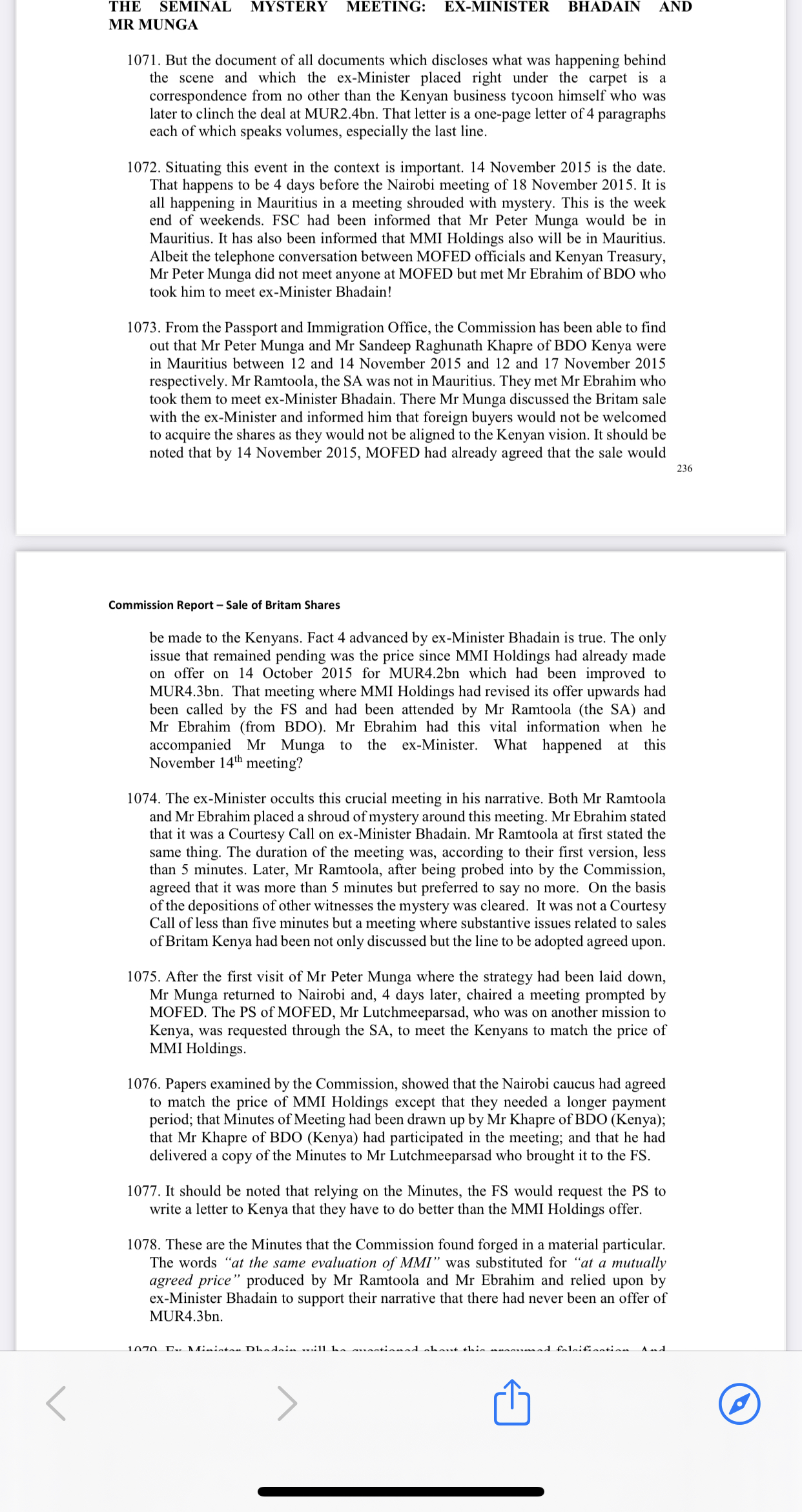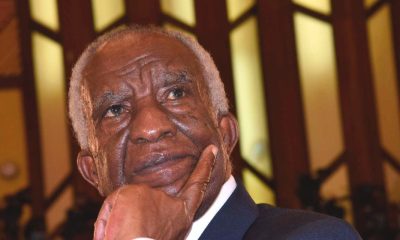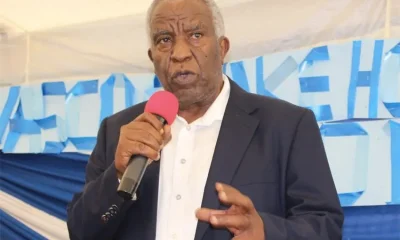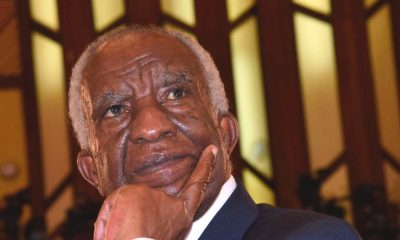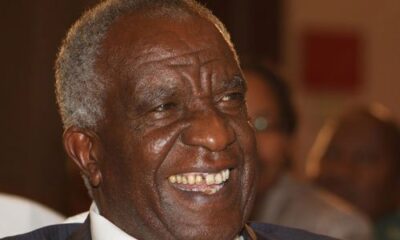Business
Mauritius Commission Report: How Peter Munga Duped Country’s Top Minds In Britam Shares Deal
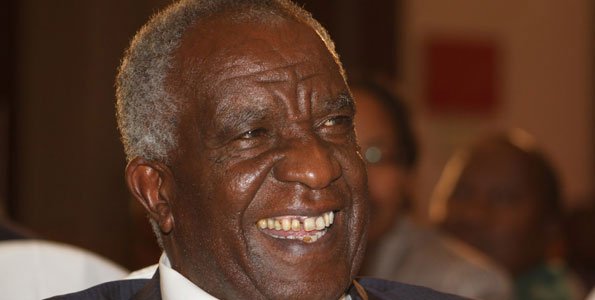
Four years after the establishment of the commission of inquiry on Britam Holdings Ltd, the report was tabled in the Mauritius National Assembly on Tuesday, July 27. The purpose of the investigation was to find out the circumstances in which the sale of the shares held by BAI Co (Mauritius) Ltd within Britam Holdings Ltd (Kenya) took place. Ex-judge Bushan and his two assessors listed 31 recommendations, including the initiation of a criminal investigation against ex-minister Roshi Bhadain, among others.
The Mauritian government was disposing of the 452,504,000 shares seized from disgraced Dawood Rawat — who it accused of running a Ponzi scheme.
The Mauritian government took control of Mr Rawat’s stake in Britam following the collapse of Bramer Banking Corporation (BBCL), which was part of Mr Rawat’s Seaton Investment conglomerate. The collapse followed a run on the bank after it was linked to a Sh69.3 billion Ponzi scheme.
The Mauritian government then opted to sell Mr Rawat’s assets to pay its citizens who had been duped in to the scheme.
The Mauritian government took a 3.5 billion Mauritian Rupee (Sh9.9 billion) loan from its central bank to pay investors.
Through his investment vehicle Plum LLP, Britam Chairman Peter Munga acquired the stake belonging to Dawood Rawat. He walked away with 24% stake valued at Sh7.1 billion but the Mauritians felt that Munga shortchanged them and dealt them a blow leading to the constitution of the committee.
The report of the commission headed by former Supreme Court judge Bhushan Domah looking into the sale of Britam Kenya shares seems in large measure to agree with former BAI head Dawood Rawat’s explanations as to what happened in that deal. The sale of Britam Kenya – an asset held by the ex-BAI Group that collapsed in 2015 – was supposed to be used to reimburse policyholders and investors.
To start with, there did not seem to be any shortage of buyers. This, the commission learnt from the testimony of Yogesh Rai Basgeet, partner at PwC Mauritius, who along with Mushtaq Oosman, were the first special administrators in charge of disposing of the ex-BAI assets. According to Basgeet, six investors approached them to buy the 23.92 percent stake held by the ex-BAI in Britam Kenya, with offers ranging from Rs4.2 billion to Rs4.5 billion.
However, the Financial Services Commission (FSC) did not approve the sale preferring instead to transfer the shares to the National Property Fund Ltd (NPFL). Oosman was pushed out as special administrator on August 14, 2015 over the Rs6 million sale of Solis – a company of the ex-BAI group – which the FSC and the parent ministry insisted had to be cleared by them first. Basgeet was soon to follow, resigning as special administrator on August 26, 2016. They were replaced by Yacoob Ramtoola of BDO.
By October 2015, South African group MMI Holdings offered to buy the stake in Britam Kenya for Rs4.2 billion. On October 14, 2015, a meeting was held between financial services minister Roshi Bhadain, financial secretary Dev Manraj and a representative of MMI Holdings where they upped their offer to Rs4.3 billion.
The interest of MMI Holdings as well as Basgeet and Oosman’s arguments in the commission report about the stake in Britam Kenya would seem to agree with Dawood Rawat’s version that the asset was a good one. In written notes prepared for the commission, Rawat stated that the stake in Britam Kenya allowed him to control who became CEO and CFO of Britam Kenya as well as the fact that he himself had had four meetings with MMI Holdings to sell off the stake before BAI went bust. Rawat argued that audit firm McKinsey had forecasted the value of the shares to reach Rs10 billion by 2016 and at least Rs15 billion by 2018.
Peter Munga pushes MMI Holdings out
It was at this stage that Britam Kenya chairman, Peter Munga, comes into the picture. On November 14, 2015, he met with Bhadain, Afsar Ebrahim of BDO Mauritius and Sandeep Khapre of BDO in Kenya. At that meeting, the commission notes, Munga said that Britam Kenyan shareholders did not want a sale of Britam shares to a non-Kenyan company, MMI Holdings. It goes further to hint that Bhadain and Munga had hatched a plan to push the deal through.
But there is a problem with the commission’s narrative here: while it confidently declared that November 14, 2015, was a conspiracy, in the same breath it goes on to state, “it is because a line of action had been agreed upon between ex-minister Bhadain and Peter Munga, the details of which only those who participated in the meeting will know: Peter Munga, the ex-minister, Messrs Afsar Ebrahim and Khapre”. In other words, the commission knows that there was a ‘conspiracy’ hatched at that meeting, but just what that conspiracy was, it declined to mention.
But to what extent was this true that Britam and some in the Kenyan government did not want to see foreigners get into Britam? The commission’ report does not get much into this. So, once again we must turn to Rawat’s version: In January 2017, the International Finance Corporation (non-Kenyan) bought a 10.37 percent stake in Britam for Rs1.2 billion.
Then in September 2017, another 14.3 percent stake was sold to Africinvest, a Tunis-based company for Rs1.94 billion. In fact, Munga’s own company Plum LLC, after he bought the shares from the Mauritian government, went on to sell a 13.81 percent stake in Britam to Zurich-based Swiss Re for Rs1.61 billion.
Whatever concerns Munga said there was about selling to non-Kenyans seemed short-lived. At any rate, it sufficed to push MMI Holdings out and Munga, ostensibly representing a pool of Kenyan investors, in. Manraj said he had no problem selling to those Kenyans if they matched MMI’s offer of Rs4.3 billion.
Then permanent secretary to finance ministry Vidianand Lutchmeeparsad, already on an official mission to Kenya, was asked to negotiate with Munga. He met with Munga and Khapre in Kenya on November 18, 2015, and officially told the finance ministry, led by Lutchmeenaraidoo and Manraj, that Munga and Britam had agreed to buy the stake for Rs4.3 billion.
On December 11, Rotich sent a thank-you note to Manraj for securing the deal for the Kenyans. So far, Munga had been dealing with both Bhadain and Lutchmeenaraidoo separately. At least that’s according to the commission’s version of events.
Lutchmeenaraidoo out, Bhadain in
In February 2016, however, Lutchmeenaraidoo bowed out as finance minister, with Sir Anerood Jugnauth then telling the commission that government had put Bhadain in charge of the file. A big deal for a first time minister and parliamentarian. The offer to Lutchmeenaraidoo was out too, it seems. On a visit to Mauritius, Britam’s finance director Gladys Karuri and Afsar Ebrahim of BDO entered talks from March 8 to 12, 2016, at the end of which the deal was signed for Rs2.4 billion, instead of the original Rs4.3 billion offer.
What happened? The commission blamed several factors for this: contrary to what Bhadain was saying that the money was needed quickly to pay a tranche of SCBG and BAML holders in June 2016, the commission took Oosman’s point that the money for that was already there as a Rs3.5 billion loan from the Bank of Mauritius. “There was no dire need to fix the sale price, more particularly when the share price was so low,” the commission noted.
The next thing Munga did was argue that the share prices should determine the deal value and managed to push the sale down to Rs2.4 billion. With no transaction or legal adviser to look over the deal, it seems, that Mauritians just bought this without considering that this was a major stake in the company that carried with it the power to determine management (as Rawat had earlier argued).
That, and the fact that the share price had not changed much, the commission noted, between MMI’s and Munga’s earlier offer of Rs4.3 billion, and the deal signed by Bhadain for Rs2.4 billion. The commission seemed to accept Manraj’s view that, since this was not the sale of a government asset, Bhadain could sell it on his own without cabinet approval, though he would have to take responsibility for what happened afterwards. If true, having a neophyte minister negotiate a deal worth billions on his own without consulting anyone else is an amazing bit of governance on its own.
Munga gets the better of everyone
As it turned out, Munga did not represent a pool of investors, but his own company Plum LLC bought the shares undersold by the Mauritian government. Some of which he then went on to resell to other entities. “Peter Munga was a business tycoon and all the Mauritian professionals involved put together were no match for him singly alone. He was able to dictate both time and terms, price and party,” the commission concluded.
Munga managed to get Britam shares at 44% discount to best offer by first saying Kenyan shareholders did not want the sale to be done to foreign shareholders. Then he offered to match best offer which was at 50%+market price when the share was at close to Shs 18.
By the time they were closing the deal in 2016, the share was trading at Shs 11 and Kenya shilling had dropped 11%. A year later shares were sold to foreign buyers. Strategy used by Munga’s team was to represent the assets as less attractive than they actually were.
Bhadain, the FSC, NPFL (who technically owned the shares) and BDO fell for it and Munga, the report continues, “Mr Peter Munga represented to them and the world at large that he was doing Mauritius a favor. He had perfected the art of buying gold at the price of chaff”.
In it’s finding, the commission alleges that Munga used backdoor to negotiate the deal. It stated below in findings.
a) the source of the problem was Section 110A & Section 110B of the Insurance (Amendment) Act 2015;
(b) on 14 November 2015, Mr Peter Munga has met ex-Minister Bhadain along with BDO and decided to proceed “along the line agreed at our
meeting”;
(c) On 18 November 2015, Mr Peter Munga chaired a meeting in Nairobi and responded to MOFED that they were prepared to match the price
of MMI (i.e. MUR4.3bn);
(d) MOFED exited the scene in early February 2016;
(e) from then on, matters were followed by phone calls following which Mr Peter Munga and his team landed in Mauritius on 8 March 2016 with a draft MOU incorporating in what must have been decided not in the meeting of 18 November 2015 with MOFED but in the meeting of 14 November 2015 with ex-Minister Bhadain and BDO;
(f) had the undertaking been transferred to NPFL as had been decided by Cabinet and known to the ex-Minister Bhadain, SA and BDO, the NPFL would have gone through the procedures of the sale and exercised its key ownership rights as per established procedure;
(g) the short-fall of MUR1.9bn was obviously:
(i) the lack of proper methodology and evaluation;
(ii) the absence of proper negotiation; and
(iii) the non-existence of a transaction advisor and legal oversight.
“Nearer the time of the sale, one event will change the course of history regarding the price at which it went. That was his meeting with Mr Peter Munga, a Kenyan business tycoon. That was in his office, on a Saturday, without the benefit of the experience of public officers and in company of some condescending BDO professionals. Here the ex-Minister and Peter Munga would agree on a line to follow. And the people who would be involved: i.e. BDO, the ex-Minister’s favoured firm. From then on, what was overt with MOFED became covert with MFSGG&IR. The small Kenyan team would be no match for the small Mauritian team, in all respects. Even if the price of MUR4.3bn had been obtained by MOFED, the Kenyans would win over the naïve Mauritian team.”
THE MYSTERY ABOUT PLUM LLP
Plum LLP the company used Munga to gain the shares became a major center of focus after it emerged to having more questions than answers.
“MOFED had originally agreed that the sale of the shares be done to MMI Holdings at MUR4.3bn. Intervened Mr Henry K. Rotich, the Cabinet Secretary/National Secretary of the Kenyan Government to request that it be sold to the Kenyans because the Britam shareholders would not be aligned to the vision of the Kenyan investors. MOFED agreed on condition that they matched the MMI Holdings price or did better because Kenya is a friendly country. Mr Peter Munga came to Mauritius and met ex-Minister Bhadain and they agreed on the line to be followed. Who finally was the buyer? It was Plum LLP, formed and registered on the very day of the sale: 10 June 2016, with Mr Peter Kahara Munga as the Manager of Plum LLP.”
As much as it sounds ridiculous that Mauritius didn’t do their due diligence to determine if the company was registered only to realize in the last end that they were dealing with a non existent company.
“The mystery around “a pool of investors” mentioned in the MOU would come to light only then. There was no pool of investors finally. It was all the set-up of one person and one person only. He happened to be the key actor, the producer, the director and the funder of the film: Mr Peter Munga. He was the real purchaser of the Britam shares. Had a CDD been done by the Mauritians involved with a simple question “who was behind the “pool of investors”. This would have come out. Capacity to pay the MUR4.3bn would have been in issue. Behind the façade of “pool of investors,” Mr Peter Kahara Munga had been able to dupe the big Mauritian brains in broad day-light.” Report reads.
Plum LLP had at the material time as partners Mrs Rose Kahara Munga, the wife of Mr Peter Kahara Munga and Pioneer International University Trust which itself had as trustees no other persons than Mr Peter Munga himself, his wife and children(Alex Kiemi and Beth Nyambura). Plum LLP and Pioneer Trust is the same person which is Peter Munga, a tiny detail that he cleverly hid during the negotiations and they were too blind to see it.
”All the démarche of Mr Munga, geared towards the purchase of the shares of Britam, was shrewdly operated behind the veil of the term “pool of investors”, a non-legal entity which became Plum LLP only on the day of purchase on 10 June 2016. That façade would have come to light if the right questions had been asked from the beginning. The Senior Officials of the Government of the Republic of Kenya had their role to play in it.” Report notes.
Interestingly, the deal was struck in Kenya shillings which shifted fx losses to Mauritius. Then the conversion to USD was done at Equity Bank where Munga was an executive.
The conversion in Kenya made sure that Mauritius could not get the US involved in investigations.
“The Commission’s analysis of facts and figures show, accordingly, that there occurred a shortfall of USD 549,454.90 by no means negligible, by which the NPFL was prejudiced due to the favourable exchange rates used for conversion at the choice of the buyer instead of the seller. We have seen that the transaction was struck in Kenyan shillings. But it is to be noted that it was not NPFL which received the money in Kenyan shillings to convert it in US dollars. It was the buyer, Mr Peter Munga, who decided to convert the money at a bank chosen by him. In fact, it was a bank of which he was a non-executive Chairman. What difference would it make? The difference it would make is that Mauritius would be highly exposed to the evolution of the exchange rate of the Kenyan shillings. The second difference is that had the money been changed in Mauritius by a Mauritian bank, it would have been possible for the Commission to seek the help of US to trace and track funds which had been moved to other jurisdictions not willing to co-operate with Mauritius to do so. With this device, Mr Peter Munga has protected himself and all those he dealt with.”
To the question as to whether Kenyan Shilling was the underlying currency of the transaction and why the Kenyan Shilling was preferred to USD.
The committee notes, “Kenyan shillings, indeed, was the underlying currency of the transaction. As to why Kenyan shilling was preferred to USD, one obvious reason has been that had it been done by USD, US would have been able to trace any foreign account where kick-backs may have occurred – which is not possible in the case of a transaction struck in Kenyan Shillings. The Kenyans have not cooperated with the Commission’s request for mutual legal assistance. Why, despite the underlying currency being Kshs, the payments were remitted in USD by the Equity Bank of Mr Peter Munga is another curious factor in the choice of the currency of the transaction.”
According to international practice in such international sale, an international currency should have been used in accordance with international practice.
If this seems familiar, it is because it is. Despite government’s problems with Dawood Rawat, its own commission of enquiry seems to have reached precisely the same conclusion that Rawat did in his notes that he wanted to submit to the commission back in 2018: “The Kenyans either duped the Mauritians or made a covert deal which is rather intriguing.”
Kenya Insights allows guest blogging, if you want to be published on Kenya’s most authoritative and accurate blog, have an expose, news TIPS, story angles, human interest stories, drop us an email on [email protected] or via Telegram
-

 Investigations2 weeks ago
Investigations2 weeks agoHow Land Grabbing Cartels Have Captured Ardhi House
-
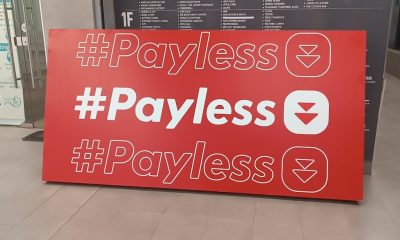
 Business1 week ago
Business1 week agoPanic As Payless Africa Freezes With Billions of Customers Cash After Costly Jambopay Blunder
-

 Business2 weeks ago
Business2 weeks agoSHOCKING LOAN SCANDAL: Mwananchi Credit Slammed for Turning Sh7 Million Loan Into Sh22 Million Debt Trap
-
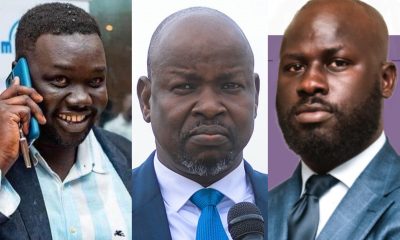
 Africa2 weeks ago
Africa2 weeks agoPredators of South Sudan: Young “Guardians” Loot Billions
-
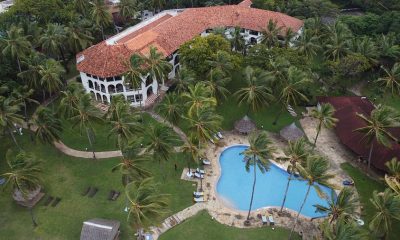
 News1 week ago
News1 week agoSCANDAL: Cocoa Luxury Resort Manager Returns to Post After Alleged Sh28 Million Bribe Clears Sexual Harassment and Racism Claims
-

 Business2 weeks ago
Business2 weeks agoMwananchi Credit Faces Massive Lawsuits After Court Flags Predatory Lending That Left Customers’ Loans Ballooning
-
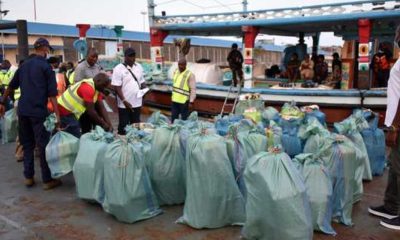
 Investigations2 weeks ago
Investigations2 weeks agoHow Arrest of a Soldier’s Spouse Dragged KDF Into Alleged Theft of Meth Haul in Mombasa
-

 News1 week ago
News1 week agoRentokil Boss Fraser Branch in Highway Smash as DUI and Racism Claims Surface

